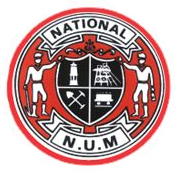Related Research Articles

The National Union of Mineworkers (NUM) is a trade union for coal miners in Great Britain, formed in 1945 from the Miners' Federation of Great Britain (MFGB). The NUM took part in three national miners' strikes, in 1972, 1974 and 1984–85. After the 1984–85 strike and the subsequent closure of most of Britain's coal mines, it became a much smaller union. It had around 170,000 members when Arthur Scargill became leader in 1981, a figure which had fallen in 2015 to an active membership of around 100.
The Miners' Federation of Great Britain (MFGB) was established after a meeting of local mining trade unions in Newport, Wales in 1888. The federation was formed to represent and co-ordinate the affairs of local and regional miners' unions in England, Scotland and Wales whose associations remained largely autonomous. At its peak, the federation represented nearly one million workers. It was reorganised into the National Union of Mineworkers in 1945.
The National Winding and General Engineers' Society was a trade union in the United Kingdom. It primarily represented stationary engineers employed at underground coal mines to operate the winding engines which ran the mining hoists. The operation of the mining hoist was a crucial part of the operation of a colliery and the engineers who ran them were generally more skilled than the general mineworkers, who were represented by the Miners' Federation of Great Britain (MFGB). The demarcation between engineers and miners often led to conflict between the two unions, as the MFGB aimed to be an industrial union, representing all employees in coal mining. The engineers' union was affiliated to the Trades Union Congress. It merged with the Transport and General Workers' Union in 1935.

The National Union of Scottish Mineworkers (NUSW) is a trade union in Scotland, founded in 1894 as the Scottish Miners Federation. It joined the Miners' Federation of Great Britain, and in 1914 changed its name to National Union of Scottish Mineworkers. It survives as the National Union of Mineworkers.
The National Union of Blastfurnacemen, Ore Miners, Coke Workers and Kindred Trades (NUB) was a trade union in England and Wales which existed between 1888 and 1985. It represented process workers in the British iron and steel industry.

The Amalgamated Textile Workers' Union (ATWU) was a trade union in Great Britain.
The Cumberland Miners' Association was a trade union in the United Kingdom.
The Amalgamated Association of Miners (AAM) was formed in 1869 in Lancashire, at a time of increasing industrial conflict in the British coalfields.
The South Yorkshire Miners' Association (SYMA) was an early British trade union representing coal miners in the southern West Riding of Yorkshire and northern Derbyshire.

The Somerset Miners' Association or Somersetshire Miners' Association was a coal mining trade union based in the Somerset coalfield, Somerset, England.
The Cleveland Miners' and Quarrymen's Association was a trade union representing ironstone miners in the Cleveland area of England.

The National Union of Cokemen and By-product Workers was a trade union representing workers involved in turning coal into coke at collieries in Great Britain. It survives today as the Cokemen's Area of the National Union of Mineworkers.

Thomas Halliday was a British trade unionist.
The Derbyshire and Nottinghamshire Miners' Association was an early union representing coal miners in parts of the East Midlands of England.
William Brown was a British coal miner who became a prominent trade unionist.
The Durham Colliery Mechanics' Association was a trade union representing mechanics working at coal mines in County Durham, in England.
The National Federation of Colliery Enginemen and Boiler Firemen was a union federation in the United Kingdom. Its membership changed over time, but was centred on unions representing enginemen at coal mines.
The Notts Trades Council, formally known as the Nottinghamshire Nottingham and Mansfield Trades Council, brings together trade unionists in Nottinghamshire, in England.
The Monmouthshire and South Wales Miners' Association was a trade union representing coal miners in south eastern Wales.
The Aberdare, Merthyr and Dowlais Miners' Association was a trade union representing coal miners in part of Glamorgan in South Wales.
References
- 1 2 Machin, Frank (1958). The Yorkshire Miners: a history. Barnsley: Yorkshire Area of the National Union of Mineworkers. p. 126.
- 1 2 3 4 Arthur Marsh and Victoria Ryan, Historical Directory of Trades Unions, vol.2, pp.228-229
- ↑ John B. Smethurst and Peter Carter, Historical Directory of Trade Unions, vol.5, pp.481
- ↑ Dictionary of Labour Biography, vol.I, p.256
- ↑ Arthur Marsh and Victoria Ryan, Historical Directory of Trades Unions, vol.2, p.244
- ↑ Fynes, Richard (1873). The Miners of Northumberland and Durham. pp. 260–263.
- ↑ Robin Page Arnot, The Miners, vol.1, pp.94-95